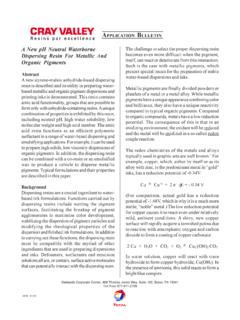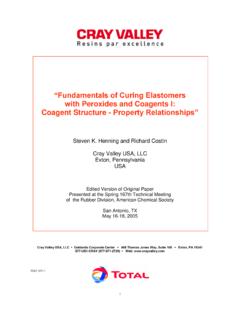Transcription of Liquid 1,2-Polybutadiene Resins as Additives To EPDM and ...
1 5708 07/11 Liquid 1,2-Polybutadiene Resins as AdditivesTo epdm and Other ElastomersFor The Oil IndustryCray Valley USA, LLCE xton, PennsylvaniaUSACray Valley USA, LLC Oaklands Corporate Center 468 Thomas Jones Way, Suite 100 Exton, PA 19341 877-US1-CRAY (877-871-2729) Web: polyfunctional polymers and monomers havebeen used for many years to increase crosslinking inEPDM and EPM elastomer systems, and in manyother elastomer systems as ,2,3 One of thebetter known materials for this purpose istrimethylolpropane trimethacrylate (TMPTMA). Liquid 1,2-polybutadienes have also been studied andused for this ,4,5 This paper is directed toapplications in epdm elastomers for oil fielddownhole use.
2 It presents experimental data on thegeneral property improvements to be expected fromlow concentrations of 1,2-polybutadienes in peroxidecured epdm and EPM. Data is presented whichshows that higher concentrations of 1,2-polybutadieneresins result in improved heat, chemical and oilresistance. Papers by A. R. Hirasuna and coworkersat L Garde Inc. illustrating how 1,2-Polybutadiene canbe used in geothermal steam applications and discussimplications for the oil industry are ,12 Thishas led to new applications in severe environments suchas deep oil compounds used in this study were prepared on atwo-roll laboratory mill from a series of master compounds were mixed taking care that therewere minimum variations in milling and temperatureparameters.
3 Tests were conducted with carefuladherence to conditions specified by the variousASTM methods and these are listed for data whereversuch data appears in the text. Nordel 1440 wasselected as the principal epdm to be studied. Theinitial study was designed to test physical propertiesobtained with various concentrations of 1,2-Polybutadiene and to compare the properties soobtained with epdm containing no polybutadieneand epdm containing trimethylolpropanetrimethacryiate. Cray Valley s Ricon 153 was the 1,2-Polybutadiene used. These materials were fromproduction batches and were used without furtherpurification. The 1, 2- polybutadiene used had anassay for vinyl content of 82 percent and molecularweight by Gel Permeation Chromatography(M = 3140).
4 Master Batch A was made with thefollowing composition by weight: Nordel 1440, phr; SRF N-762 carbon black, phr;ZnO, phr; Agerite Resin D, phr. MasterBatch A was mixed on a two roll mill with catalyst,coagents and other Additives as required. Thesecompounds are shown in Table 1. The sampleswere cured 25 minutes at 160 C. The samples wereprocessed and aged for 72 hours at 100 C. Agedphysicals were determined with results shown inTable 1. Mooney viscosity and scorch by ASTM method D-1646 is presented in Table data is presented in Figure 1 forperoxide cured specimens of 1, 1 Formulation Nordel 1440 100 100 100 100 100 SRF N-762 50 50 50 50 50 Zinc Oxide Agerite Resin D
5 Rico n 153 -- -- T MPT MA -- -- -- -- 2. 5 Dicup 40C Aged Physicals: Aged 72 hrs.
6 @ 100 C PBD 0 2 5 10 -- TMTM -- -- -- -- 2 Tensile Mp a D-573 Elo nga tio n % D-57 3 440 3 70 310 2 50 410? 100% Modulus, Mpa D-573 200% Modulus, Mpa D-573 300% Modulus, Mpa D-573 - 400% Modulus.
7 Mpa D-573 - - - Hardness, Shore A D-2240 60 63 63 65 63 Co mpression Set D-395, Method B 3 Chemical resistance data was obtained at roomtemperature for mineral filled samples completelyimmersed in solutions specified in Table 3 and 4. Itwas sometimes necessary to weight the samples inorder to keep them immersed in the test immersion, the test samples were washedwith distilled water, blotted on absorbent paper andweighed to determine loss in weight.
8 Samples wereimmediately tested for hardness and flexural strengthwithout conditioning to standard humidity evaluated in boiling solvents were placed ingently boiling liquids, and not in the vapor space. Theywere weighed and tested like the room temperaturespecimens described above. Wherever possible thematerial attacked was designed to be the resin andnot filler or additive. For example, samples containingsilica were not tested in aqueous sodium hydroxidesince the filler would be expected to undergo 24 Table 3 Chemical resistance of 1,2 polybutadiene mineral filled molded specimens 80% filler: 20% was 30 days at room temperature. There were no significant changes in flexural strength, flexural modulus orhardness with the following:TolueneRed fuming nitric acidMethyl ethyl ketoneConc.
9 Nitric acidDimethyl sulfoxideConc. Hydrochloric acidCarbon tetrachlorideGlacial acetic acidTetrahydrofuran70% sulfuric acidChlorobenzeneLiquid bromineDistilled waterIsopropanol5% nitric acidFormalinConc. nitric acid developed red color on the surface; conc. sulfuric acid darkened to black on surface and lost somephysical strength; saturated chromic acid caused some darkening but little change in physical 4 Chemical resistance of 1,2-Polybutadiene mineral filled molded specimens at elevated temperatures: 20% resin: 80% one week at refluxing C% WeightChange% FlexStrength ChangeHardnessChangeTap Water100+ + +4-35-2 DMSO189+ +15+12 Glacial Acetic Acid118+ +596% H2SO4200+5-50-920% H2SO4100+2+5+110% NaOH(1)100+2-2+1(1) Coke filled specimen; silica filled sample was attacked severely when and DiscussionOil wells are operating in more difficult environmentsthan ever before.
10 Wells are being drilled deeper,dramatically increasing temperature and pressureconditions which the downhole elastomer mustwithstand. In addition, harsh chemicals and steam arebeing injected into the well for various currently in use are no longer doing anadequate job in these more difficult older elastomers react to brine and oil at 260 Cas shown in Table 51. Butyl (IIR)-softens, undergoes reversion2. Nitrile (NBR)-hardens and becomes nonelastic. Embrittles on aging in presence of Epichlorohydrin (CO)-softens, hydrolyzes, epdm -softens, swells, resists chemical Fluoroelastics (FKM)-embrittles on aging, looses Polyacrylics (ACM)-not resistant to hot water and steam at 260 Chloroprene (CR) Silicone (VMQ)-has good physicals, but swells in hydrocarbons and is destroyed in 260 C brine99.









